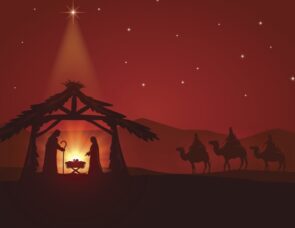The second of a series of three sessions to pick up the three events we associate with the season of Epiphany: three ‘manifestations’, ‘signs’ or ‘clues’ as to who Jesus is.

Get set
The mini series is based around creating a wall display of a piratical treasure map with the three clues on. For details of how to start, see the first of these three sessions, Epiphany – the wise men.
Go!
1 Very briefly remind the group what Epiphany is: a time of signs or clues as to who Jesus is. What was last week’s clue? What did it tell us about Jesus? Explain that about thirty years have gone past, and in this week’s story, Jesus is grown up.
2 You could use the Godly Play version of the baptism of Jesus or use the following:
Set a big deep bowl of water in the centre and encourage everyone to dip their hands in. Have some separate glasses of water to drink.
(If you have time, have a wonder at the water’s properties:
Show how things change in different ways when they go underwater:
Some things just get wet but stay the same: put in a sponge / polythene bag / rubber glove / plastic toy and bring it out – when it dries it will not have changed.
Some things look changed but are really no different:
Watch how a straw looks bent in water
Some things are completely changed by the water:
Drop in one of those facecloth pills that rehydrate and become something totally different, or a fizzy pill like a soluble Alka Seltzer (best to drop it into a glass of water to avoid children inadvertently drinking it from the bowl) or some of those dried prehistoric larvae things that are brought to life by the water. The children may have other ideas.)
3 Ask for a volunteer to get their hands really dirty with paint / clay / mud / jam. Then wash off the dirt in the water.
OR cover a little mirror with mud or paint, ask if you can see anything in it, then wash off the dirt and see what’s reflected.
Talk about the way that we are supposed to reflect God, but that ‘sin’ stops us reflecting his goodness, and we need to let him wash it away.
John the Baptist knew that water itself doesn’t change people on the inside but it could be a sign that they had changed on the inside.
4 Tell the story of Jesus’ baptism from a story book, the della Francesca painting or similar from the National Gallery website. The following key points may be useful as you retell the story:
- John was Jesus’ cousin, and he lived in the desert. His job was to get people ready for God’s promised rescuer – the Messiah.
- He did this by showing people where their lives were ‘dirty’ – the things they did that mucked up the God in them – and helped them say sorry and to start again.
- He did this through baptising them: they would go down into the River Jordan, go underwater and come back up again as a way of showing they wanted God to wash away the dirty things that stopped them being like God and to start again.
- One day John saw Jesus coming and knew he was God’s promised rescuer – the Messiah. Jesus asked John to baptise him, just like everyone else… but John knew Jesus had no dirt in him at all. He was just like God in every way. He didn’t have anything to wash away. But Jesus said, ‘Let it be this way for now. We should do everything that God wants.’
- As soon as Jesus was baptised, just like everyone else, he came up out of the water, then heaven opened and he saw God’s Spirit come down on him like a dove and heard a voice from heaven: ‘This is my Son. I love him and I’m very pleased with him.’
5 If you’re using a picture, talk about it together:
What can you see in the picture?
What do you like about this picture?
What is the most important thing in the picture?
How can you show a voice in a painting?
6 In today’s story, what’s the biggest clue about who Jesus is?
Together make your own picture of Jesus’ baptism, each person creating the part that they think is most significant (the water, the dove, the voice, John, locusts!) and talk about why they’ve chosen that part of the story. Assemble all the component parts on your display as the second clue.
7 Prayer: Use the water to dip hands in and to think quietly about the way water changes things and the way God changes people.

 Download
Download